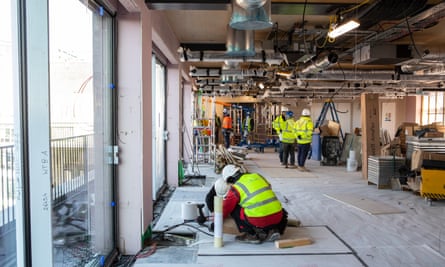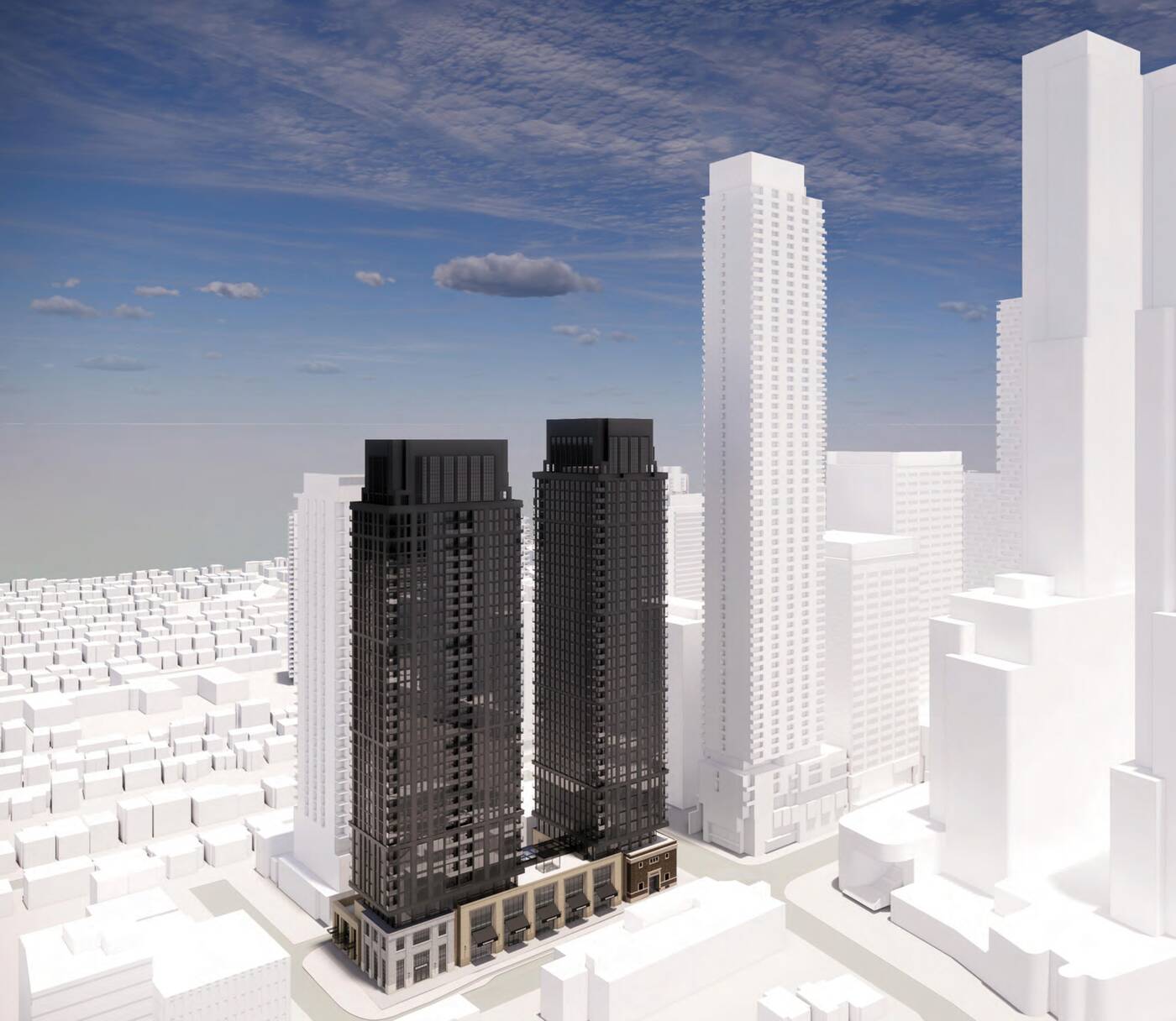Real eState
Old walls, new life? Britain’s builders embrace the retrofit revolution
|
|
A stone’s throw from London’s affluent Sloane Square, a 1980s redbrick facade hides a fully revamped office building, partially built from reclaimed materials. The new features include larger, opening windows, higher ceilings and two “green walls” of living plants on the outside. The car park at the rear has given way to almost 80 cycle spaces, along with lockers and showers.
Holbein Gardens, which is nearly complete and will house up to 260 workers across six floors, is Grosvenor Group’s first net zero carbon office building in its 346-year history – and Grosvenor is keen to points out that it is net zero in operation, without relying on carbon offsets. The Duke of Westminster’s property company, which owns swaths of London’s most exclusive neighbourhoods in Mayfair and Belgravia, decided to redevelop the mid-1980s concrete-frame building and add another storey – the latest example of the nascent “retrofit” boom.
Retrofitting is a conscious move away from the practice of knocking down office blocks after 25 to 30 years to build again, and it is starting to catch on. For instance, the US bank Citigroup plans a major overhaul of its 42-storey tower in Canary Wharf, to be completed in early 2026.
Retrofitting the UK’s historic buildings, from Georgian townhouses to the mills and factories that kickstarted the Industrial Revolution, could generate £35bn of economic output a year, create new jobs and help the government achieve its climate goals, according to a new report jointly authored by the National Trust, the housing trust Peabody, Historic England, the crown estate and Grosvenor.
The British Property Federation (BPF) supports a “retrofit first” approach, and wants the government to introduce an “overarching retrofit strategy and tax incentives”.
“There certainly is a shift,” says Tim Downes, development director at British Land, one of the UK’s biggest developers. “Carbon saving has undoubtedly gone up the agenda for, I hope, all developers but certainly all of the publicly listed developers, particularly on the commercial side.”
Higher borrowing costs, following the Bank of England’s 10th interest rate rise to 4% in February, are another factor. “As interest rates go up, the cost of capital goes up,” says Anna Bond, an executive director at Grosvenor. “You can quickly find that it becomes commercially unappealing to take forward large projects. While every building is different, retrofits can offer a more cost-effective way to create highly sustainable modern office space that can attract competitive rents.”
When deciding whether to retrofit or knock down and build again, developers have to weigh up the balance between “operational” carbon – having a brand-new building that is highly energy-efficient to run – against “embodied” carbon – the substantial emissions caused by making building materials and constructing a building from scratch.
The World Green Building Council has calculated that two-fifths of global greenhouse gas emissions come from constructing, heating, cooling and powering buildings. The BPF has urged the government to regulate embodied carbon and has called for planning reforms to prioritise the reuse of buildings, and a VAT exemption for refurbishment works.
The real estate investment group CBRE predicts that embodied carbon associated with buildings will make up 50% of built-environment emissions by 2035, up from 28% now, as operational emissions reduce “but we carry on building”. It warns: “Without action on embodied carbon, the UK’s 2050 net zero goal is not achievable.”
CBRE says: “There are tough choices ahead around whether operationally efficient newbuilds or refurbishments are most effective at reducing overall carbon emissions. But given that 80% of 2050’s built stock is already standing, the need to reduce the impact by refurbishing existing buildings is clear.”
Grosvenor, owned by one of Britain’s youngest billionaires, Hugh Grosvenor, hails Holbein Gardens as a big step in its ambition to become net zero by 2025. Retaining the 1980s brick facade saved 59 tonnes of carbon emissions, according to the UK Green Building Council.
The windows have been enlarged, letting in more natural light, and can be opened on every floor; sensors tell you when it is a good idea to do so to save energy, says project director Philip George. Ceiling heights were expanded by leaving the cooling and heating pipework exposed.
The company has opted for low-carbon products rather than concrete, such as Thermalite aircrete blocks with tiny pockets of trapped air for high thermal and sound insulation, and cross-laminated timber. About a fifth of the steel used (24 tonnes) is reclaimed, including columns from the firm’s revamp of the Peek Freans biscuit factory in Bermondsey, east London (Grosvenor offloaded the build-to-rent project to the US developer Greystar last summer).
Other reclaimed materials include blue bricks and raised floor tiles. There is a strong market for the latter, while using reclaimed steel is “really complicated and expensive” and harder to get insurance for, says George.
Downes says material passporting – stamping specifications on to steel and other materials and barcoding them – should help as the secondhand materials market evolves. British Land is already doing this at some sites.
The future occupier of Holbein Gardens, a local asset manager in Chelsea, will save 50% on energy compared with typical London offices, Grosvenor claims.
The group has a £90m retrofit fund and spent £19m on this building. Its other retrofit projects include turning a former ice factory near Victoria station into offices and shops, and Newson’s Yard – London’s oldest timber yard, also in Belgravia – into boutiques.

“Your real estate is one of the easier ways to reduce emissions as a business,” says Bond. “Sustainability is becoming more important to occupiers, investors and employees.”
Similarly, the flexible workspace provider The Office Group has vowed to refurbish rather than build where possible. The renovated Chancery House from 1885, which still has the London Silver Vaults market in its basement, is its biggest office retrofit to date and is due to open this spring, while the revamped 1950s Parcels Building in Oxford Street will open later this year.
Charlie Green, the firm’s president, says retrofitting “gives us speed to market” and points out that “the embodied carbon is significantly lower with a refurbishment”.
In Birmingham, the Rum Runner Works, the former home of a nightclub where Duran Duran used to play, has been turned into an office building after a £2m refurbishment, overlooking a canal. CBRE, the developer, says half the space is under offer. It has also completely revamped nearby 10 Brindley Place, formerly bank offices and flats, where the flexible office operator Spacemade is moving in, along with the Caribbean restaurant chain Turtle Bay.
Despite the shift towards retrofits, British Land argues that new developments are still needed, to “deliver best-in-class buildings which are operationally highly energy efficient”. For example, it is knocking down 1 Broadgate in the City of London, built in 1987, and replacing it with a building in which energy use will be one-sixth of the old one.
Downes explains that when a building comes back to British Land after the end of a lease, it is carefully assessed to see how much can be kept. For example, the firm decided to retain the facade and most of the structure of a 2002 office block at its Paddington campus, while a retrofit of 1 Triton Square near Euston station, originally built for First Bank of Chicago in the late 1990s with a huge atrium, has been more extensive. British Land filled in some of the atrium, added more floors and refashioned the facade of the building – let to Facebook owner Meta, which is looking to sublease the space.
And not everyone is going down the retrofit route. Marks & Spencer’s decision to demolish its 90-year-old landmark store close to Marble Arch in London sparked a public inquiry last year. But chief executive Stuart Machin has said that the store is “riddled with asbestos” and “belongs to a bygone era”.





Real eState
Y Combinator alum Matterport is being bought by real estate juggernaut Costar at a 212% premium – TechCrunch


Digital twin platform Matterport has agreed to be acquired by one of its customers, Costar, in a cash-and-stock deal of $5.50 per share that gives it an enterprise valuation of about $1.6 billion. Matterport’s tech helps companies create digital replicas of physical spaces.
Costar’s offer represents a premium of a whopping 212% over Matterport’s last closing share price before the deal was announced on April 22.
The deal looks like a fortunate turn of events for Matterport, whose shares had been trading below the $5 mark since August 2022 as the company struggled to meet investors’ expectations for subscriber growth amid a sluggish real estate market and a wider macroeconomic slowdown. Matterport’s stock was trading below $2 per share before the transaction was disclosed.
The company has been trying to improve its profitability over the past year, too, according to its 2023 financial statements. However, investors haven’t been happy with the company, whose shares have been struggling since it went public via a SPAC deal in 2021, which Bloomberg reported valued Matterport at around $2.9 billion.
Matterport’s shares were trading at $4.76 before the bell on Tuesday — slightly below the $5.50 deal price, which indicates investors may be wary of the deal getting blocked by regulators, or they may be hedging their bets to account for a possible decline in Costar’s stock, since the deal has a share-based component, too. Costar’s shares, however, are up slightly since the announcement, indicating that its investors are happy with the potential benefits of the deal.
Matterport quickly rose to prominence from its start in 2011, making 3D imaging cameras, spawning out of the Microsoft Kinect hacker scene and going on to join Y Combinator’s Winter 2012 batch. Its services gained significant traction in the real estate space despite competition from alternatives such as Cupix, Giraffe360 and Zillow 3D Home.
Digital twin technology has applications in construction tech and insurtech, but demand from real estate players is particularly salient, as the pandemic accelerated the switch from in-person viewings to virtual tours, both for commercial and for residential properties.
Early-mover advantage aside, the company’s later decisions likely played an equally important role as the market evolved. It diversified into helping clients create virtual tours even with smartphones. And the addition of AI with its in-house solution, Cortex, added more differentiation to its offering, leveraging its data to generate 3D digital twins supporting additional labels such as property dimensions.
Matterport’s leadership changed over the years. Its current CEO, former eBay chief product officer RJ Pittman, took the reins in 2018 — but its fundraising trajectory was fairly smooth. Over its first decade, it raised successive rounds of funding for a total of $409 million, followed by its public debut in 2021.
“Costar Group and Matterport have nearly identical mission statements of digitizing the world’s real estate,” Costar’s founder and CEO, Andy Florance, said in a statement.
CoStar, which has a market cap of $34.84 billion, is a real estate heavyweight that operates marketplaces such as Apartments.com, Homes.com and LoopNet (for commercial real estate). This gives it direct insights into the value that Matterport can add for its end users.
In March 2024, Costar wrote in a press release, “there were over 7.4 million views of Matterport 3D Tours on Apartments.com, with consumers spending 20% more time viewing an apartment listing when Matterports were available.” The company now plans to incorporate Matterport’s virtual tours (“Matterports”) on Homes.com.
Taking to the stage at a real estate event shortly after the announcement, Florance reportedly said that allowing home buyers to view properties with their own furniture, for instance, will allow agents to provide more value and promote their brands.
It will be worth tracking what happens to Matterport’s activities beyond real estate, such as its partnership with Facebook to help researchers train robots in virtual environments.
The deal is subject to regulatory approvals, but this is more than an asterisk: In 2020, Costar’s attempt to acquire RentPath was derailed by an FTC antitrust lawsuit, and RentPath was instead bought by Redfin in 2021.
Real eState
Caution about Canada's private real estate sector abounds as valuations slow to adjust – The Globe and Mail


Valuations for Canada’s office real estate have taken longer to adjust than properties in other advanced economies.Jeff McIntosh/The Canadian Press
Sign up for the Globe Advisor weekly newsletter for professional financial advisors on our sign-up page. Get exclusive investment industry news and insights, the week’s top headlines, and what you and your clients need to know. For more from Globe Advisor, visit our homepage.
As the U.S. economy has pulled meaningfully ahead of Canada’s, so too has its private commercial real estate sector, which is adjusting more positively to the post-pandemic reality.
That’s particularly evident in both countries’ privately held office property markets. While the U.S.’s is well down the path of transforming, demolishing or otherwise ridding itself of empty office space, Canada’s has practically frozen in place following a wave of markdowns in 2023. That has made valuation assessments next to impossible.
“There’s a big dichotomy, and the Canadian market so far has not corrected,” says Victor Kuntzevitsky, portfolio manager with Stonehaven Private Counsel at Wellington-Altus Private Counsel Inc. in Aurora, Ont., which holds private real estate assets in credit and equity vehicles in both Canada and the U.S.
It’s no secret that last year was a difficult period for owners of Canadian private real estate, with many pension fund managers losing money as high interest rates drove up borrowing costs, inflation increased operating costs and vacancy rates remained high or even climbed.
The Caisse de dépôt et placement du Québec saw its real estate portfolio decline 6.2 per cent in 2023. The Ontario Teachers’ Pension Plan experienced a 5.9-per-cent loss in its real estate book, while markdowns on commercial properties owned by the Ontario Municipal Employees Retirement System (OMERS) resulted in its real estate portfolio dropping by 7.2 per cent.
However, there are pockets of strength investors can look to, says Colin Lynch, managing director and head of alternative investments at TD Asset Management Inc. These include multi-family residential and open-air retail centres, as well as industrial properties, which have been steady performers following strong gains through the pandemic.
It’s a view that dovetails with other analyses of the Canadian market. BMO Global Asset Management’s latest commercial property outlook notes that the industrial and multi-family segments remain strong due to high investor demand and tight supply.
“Office remains the asset class of the greatest near-term concern and focus,” the BMO GAM report states, estimating “a timeline for a return to ‘normal’ of a least five years.”
Mr. Lynch says while that timeframe could be accurate, private real estate investors need to evaluate opportunities on a city-by-city basis.
“Every city is very different. In fact, the smaller the city, the better the office property market has generally performed because commute times are much better, so in-office presence is much higher,” he says.
He points to cities such as Winnipeg, Regina and Saskatoon, where commute times can be 10 minutes and office workers are in four days a week on average.
However, there’s also room for more bad news, with some property owners struggling to refinance expensive debt in a higher-for-longer rate environment that could force firesales for lower-quality buildings.
The U.S. and other advanced real estate markets, such as the U.K., are “quarters ahead” of where the Canadian office market is in terms of valuation adjustments, Mr. Lynch says. A major reason is much of Canada’s commercial office real estate is owned by a relatively small group of large investment funds.
“Peak to trough in the U.K., for example, declines were about 20 per cent,” he says, noting that Canada’s market hasn’t corrected to that extent, but it is catching up.
Mr. Kuntzevitsky says these private fund assets are valued based on activity.
“The U.S. market is deeper, there’s more activity within it compared to Canada,” he says. “The auditors I speak to who value these funds are saying, ‘Listen, if there’s no activity in the marketplace, we’re just making assumptions.’”
Nicolas Schulman, senior wealth advisor and portfolio manager with the Schulman Group Family Wealth Management at National Bank Financial Wealth Management in Montreal, holds private real estate funds for clients and says he’s preparing to evaluate new investments in the Canadian space later in 2024.
“We don’t think the recovery would take a full five-year window, but we do believe it’s going to take a bit more time. Our conviction is, we want to start looking at the sector toward the end of this year,” Mr. Schulman says.
Mr. Kuntzevitsky says he’s been allocating any excess cash to the U.S. market in both private and publicly listed vehicles.
“The opportunity here is that you redeem your open-ended private [real estate investment trusts (REITs) in Canada] and reallocate the money to the U.S., where the private market reflects [net asset values] based on recent activity, or you can invest in publicly listed REITs,” he says.
Still, Mr. Kuntzevitsky is watching developments closer to home for evidence the market is turning.
In February, the Canada Pension Plan Investment Board and Oxford Properties Group Inc. struck a deal to sell two downtown Vancouver office buildings for about $300-million to Germany’s Deka Group – about 14 per cent less than they were targeting.
“Hopefully, that will activate the market,” Mr. Kuntzevitsky says. “But so far, we haven’t seen that yet.”
For more from Globe Advisor, visit our homepage.
Real eState
Proposed Toronto condo complex seeks gargantuan height increase – blogTO
A large condo complex proposed in the increasingly condo-packed Yonge and Eglinton neighbourhood is planning to go much taller.
Developer Madison Group has filed plans to increase the height of its planned two-tower condo complex at 50 Eglinton Ave. W., from previously approved heights of 33 and 35 storeys, respectively, to a significantly taller plan calling for 46- and 58-storey towers.
The dual skyscrapers will rise from a podium featuring restored facades of a heritage-designed Toronto Hydro substation building.
As of 2024, plans for high-rise development at this site have been evolving for over a dozen years, first as two separate projects before being folded into one. The height sought for this site has almost doubled in the years since first proposed, and it shouldn’t come as a huge surprise for anyone tracking development in this part of the city.


Early 2024 design for 50 Eglinton West before current height increase request.
Building on a 2023 approval for towers of 33 and 35 storeys, the developer filed an updated application at the start of 2024 seeking a slight height increase to 35 and 37 storeys.
Only a few months later, the latest update submitted with city planners this April reflects the changing landscape in the surrounding midtown area, where tower heights and density allotments have skyrocketed in recent years in advance of the Eglinton Crosstown LRT.


April 2024 vision for 50 Eglinton Avenue West.
The current design from Audax Architecture is a vertical extrusion of the previous plan that maintains all details, including stepbacks and material details.
That updated design introduced in January responds to an agreement that allows the developer to incorporate office space replacement required under the neighbourhood plan to a nearby development site at 90-110 Eglinton East.
According to a letter filed with the City, “As a result of the removal of the on-site office replacement, which altered the design and size of the podium, and to improve the heritage preservation approach to the former Toronto Hydro substation building… Madison engaged Audax Architecture and Turner Fleischer Architects to reimagine the architectural style and expression of the project.”
A total of 1,206 condominium units are proposed in the current version of the plan, with over 98 per cent of the total floor space allocated to residential space. Of that total, 553 units are planned for the shorter west tower, with 653 in the taller east tower.
A sizeable retail component of over 1,300 square metres would animate the base of the complex at Duplex and Eglinton.
The complex would be served by a three-level underground parking garage housing 216 spots for residents and visitors. Most residents would be expected to make use of the Eglinton Line 1 and future Line 5 stations across the street to the southeast for longer-haul commutes.
Audax Architecture/Turner Fleischer Architects
-



 Health21 hours ago
Health21 hours agoSee how chicken farmers are trying to stop the spread of bird flu – Fox 46 Charlotte
-



 Investment23 hours ago
Investment23 hours agoOwn a cottage or investment property? Here's how to navigate the new capital gains tax changes – The Globe and Mail
-



 Science20 hours ago
Science20 hours agoOsoyoos commuters invited to celebrate Earth Day with the Leg Day challenge – Oliver/Osoyoos News – Castanet.net
-
News20 hours ago
Freeland defends budget measures, as premiers push back on federal involvement – CBC News
-
News23 hours ago
‘A real letdown’: Disabled B.C. man reacts to federal disability benefit – Global News
-



 Politics20 hours ago
Politics20 hours agoHaberman on why David Pecker testifying is ‘fundamentally different’ – CNN
-
Economy20 hours ago
The Fed's Forecasting Method Looks Increasingly Outdated as Bernanke Pitches an Alternative – Bloomberg
-



 Science24 hours ago
Science24 hours agoEarly bird may dodge verticillium woes in potatoes – Manitobe Co-Operator






